Solar prospects have never been brighter
Radiant new figures show the global solar power market hit unprecedented highs in 2019 – and even notwithstanding the impact of the current global health crisis on global economies, experts are forecasting further bright spots in the years ahead.
With more countries pledging to reach net-zero emissions levels by mid-century, and with solar technology making great strides, the continued rise of photovoltaic (PV) technology over the past 12 months should come as little surprise.
Data research firm BloombergNEF (BNEF) recorded 121 GW of newly-installed solar capacity in 2019, with up to 154 GW extra potentially joining the ranks during 2020. If these high-end projections are met, it would take global installed capacity by the end of next year close to the 800 GW milestone.[1],[2]
This prognosis builds on strong figures from the start of 2019, which according to the International Energy Association (IEA) showed the amount of solar PV capacity installed worldwide exceeding half a terawatt (500 GW) for the first time[3].
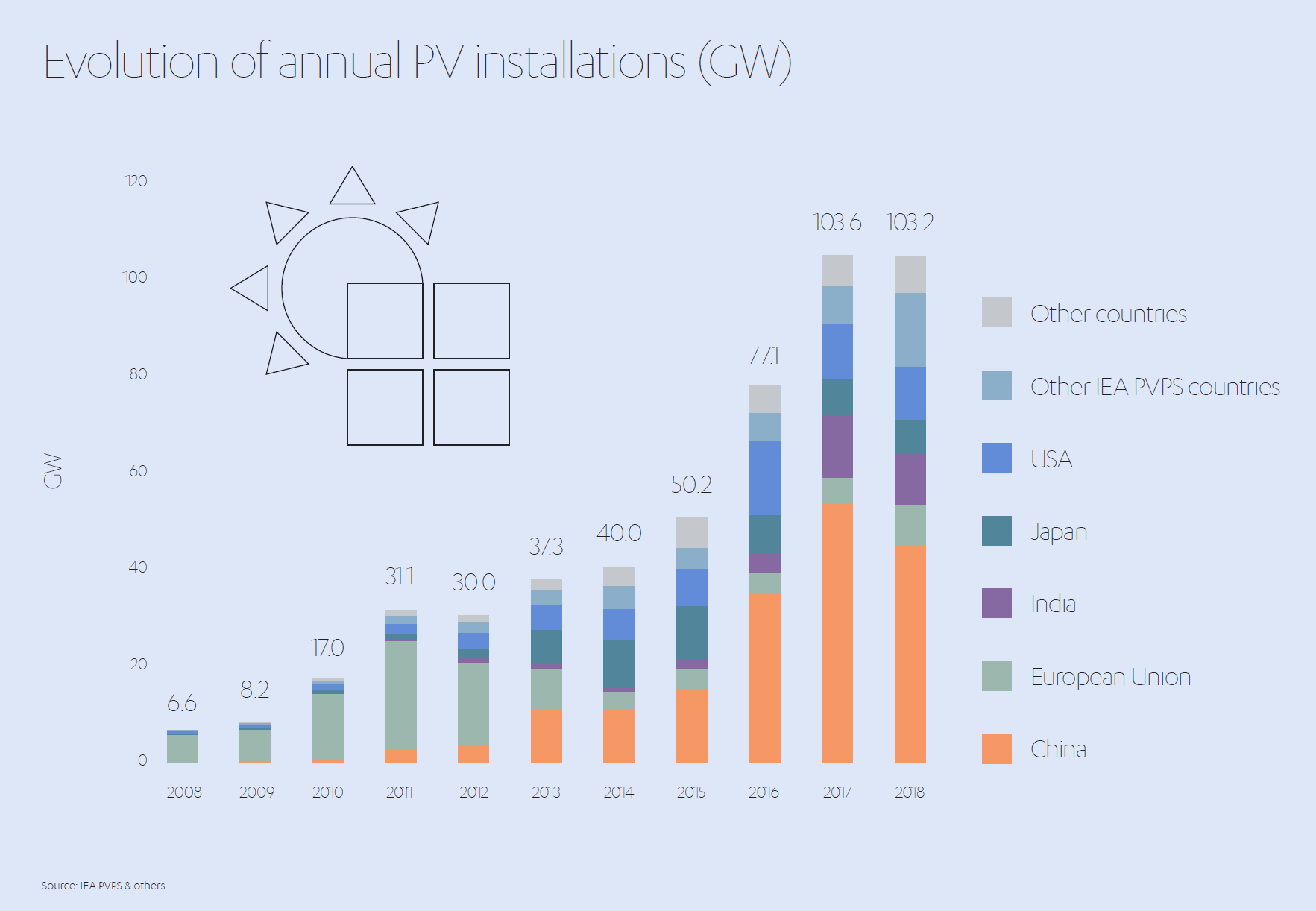
Demonstrating solar’s rapid growth, the IEA calculated that countries needed to register a PV growth of at least 1.3 GW to earn a place in the top 10 expanding markets – a new high-water mark. Meanwhile, the number of countries with at least 1 GW of installed solar capacity hit a record high of 32.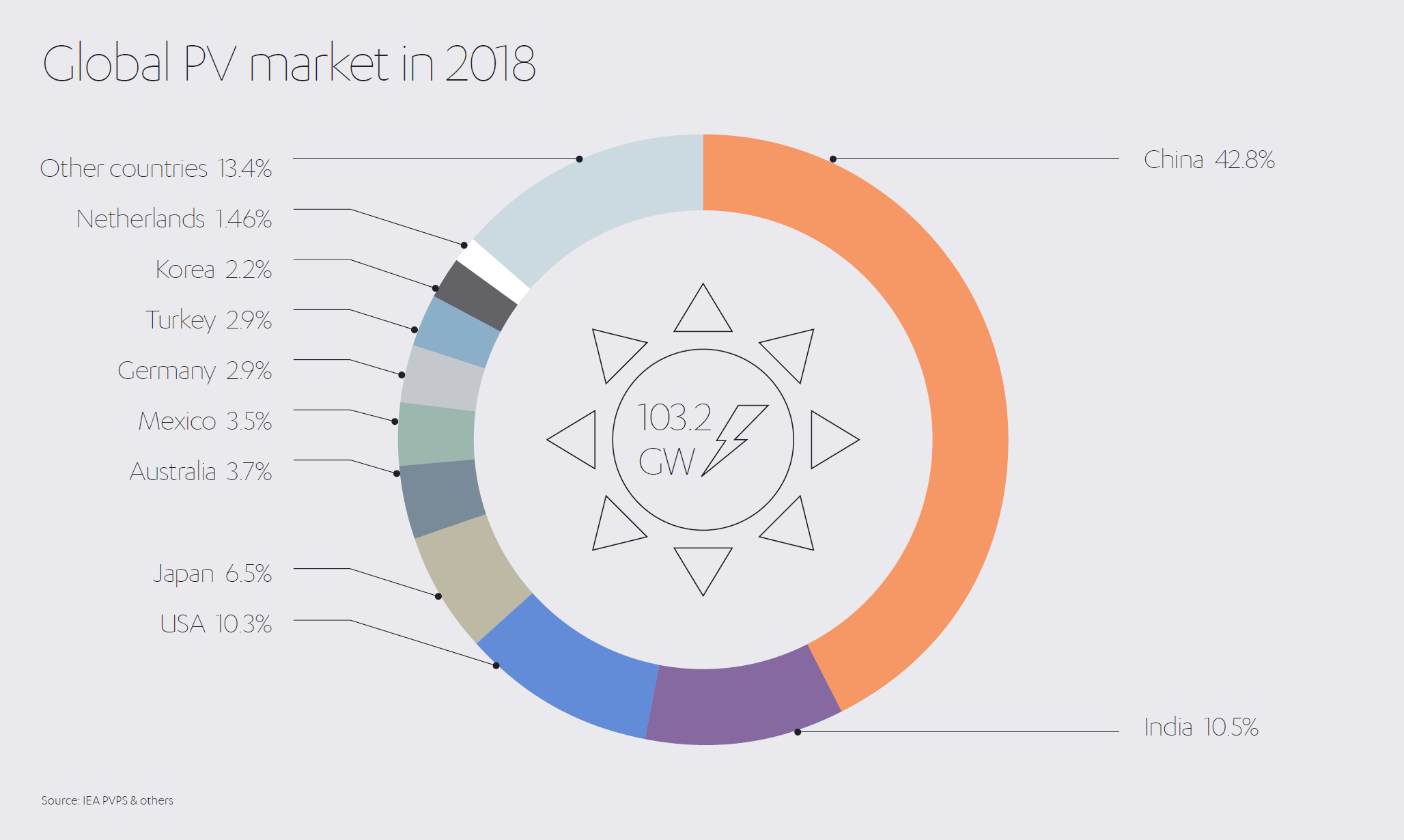
APAC soars among global pacesetters
Half of the top 10 countries for solar growth in 2019 lie within the Asia-Pacific (APAC) region, solidifying its place at the heart of the PV market. Anchal Agarwal, analyst at GlobalData, noted that APAC countries together share 58.1% of global solar PV capacity and 70.8% of new installations – a trend set to continue into the future.
“APAC is expected to remain the largest market during the forecast period 2019 to 2030 due to an increase in capacity installations,” she says. “This will be led by countries such as China, India and Japan.”[4]
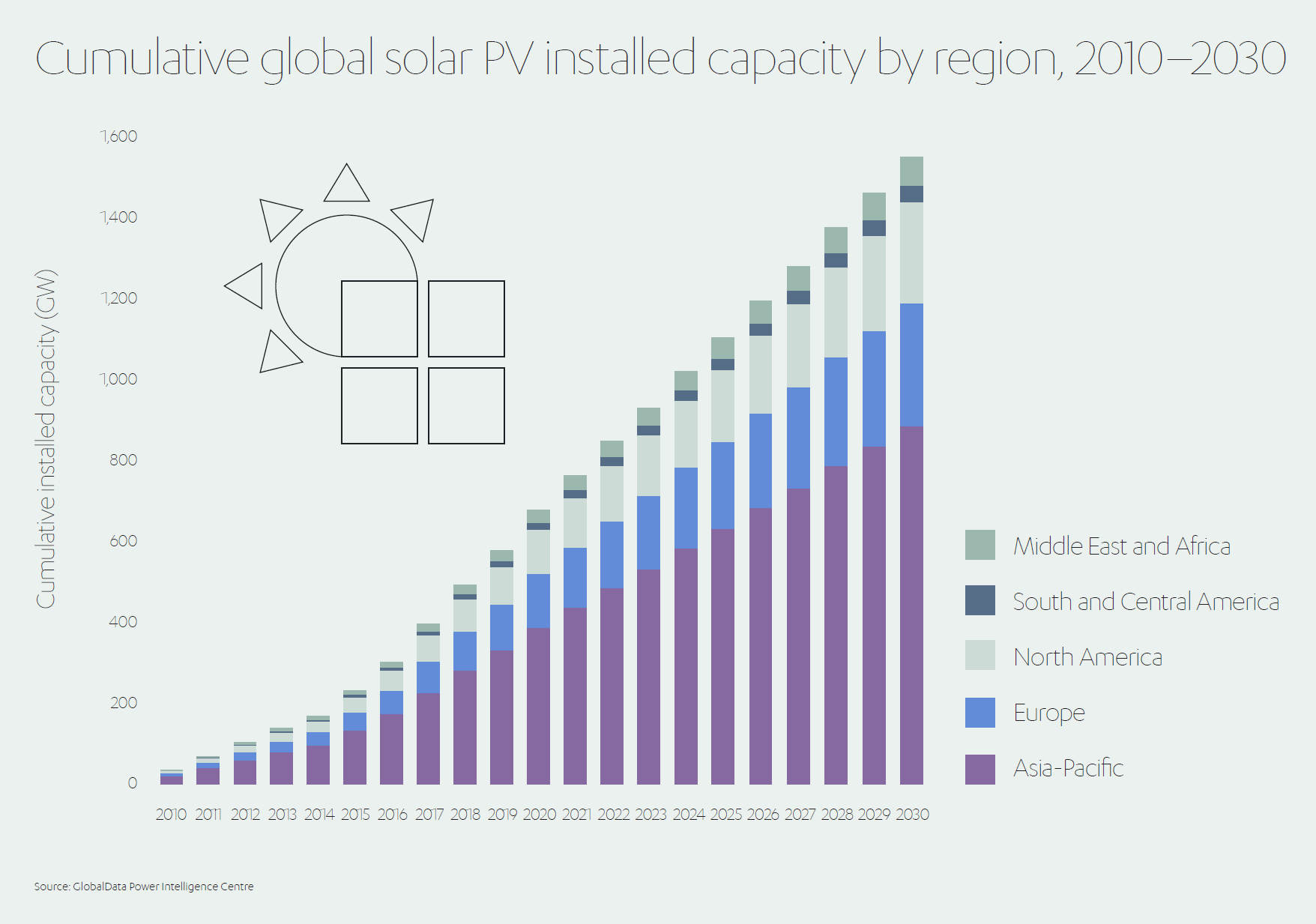
Indeed, China continues to remain at the forefront of the solar surge, reaching 204 GW of installed solar power in 2019, a rise of 30 GW on the previous year.[5] Pre-pandemic, China was targeting anywhere between 210 GW and 270 GW of PV capacity by the end of 2020 – and that is just the start of its grand vision. “During 2019 to 2030, the country is set to have the largest capacity additions each year with more than 25 GW planned to be added annually,” explains Agarwal. “About a third of global capacity addition in this period is set to be from China installations.” [6]
Flying the flag for clean energy investments in the Middle East, 2019 saw a new multi-billion solar scheme financed in Dubai, UAE.
The US$ 4.2 billion 950 MW Mohammed bin Rashid Al Maktoum IV project is a deal regarded by BNEF as “a strong signal of the appetite for solar electricity on the part of both Middle Eastern countries and international financiers.” [7] Mohammed bin Rashid Al Maktoum IV will feature the world’s tallest 260-metre solar tower, and also the largest global thermal storage capacity, at 15 hours.[8]
Showing the sector’s resilience in the face of the pandemic, in April this year the deal was signed a 25-year deal for the project’s 900 MW fifth phase.
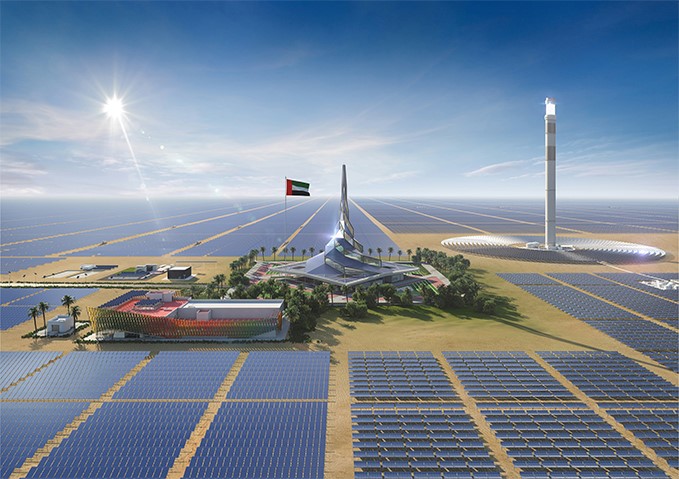
In South America, the Brazilian Photovoltaic Solar Energy Association (ABSOLAR) had anticipated private investments in solar industry exceeding R$ 19.7 billion (US$ 4.275 billion) this year, creating more than 120,000 new jobs[9]. At least 4 GW of new capacity was set to be installed throughout Brazil in 2020, either via large-scale power plants or distributed roof/ground-mounted systems. “This will practically double the current installed capacity in the country, currently at 4.4 GW,” reported the Global Solar Council.
In light of coronavirus, however, some reappraisal might be necessary, With over 20,000 deaths at time of writing, the Brazilian government has reportedly postponed its national energy generation and clean energy auctions (together comprising some 51 GW) until further notice.[10] Industry watchers will be following developments here closely.
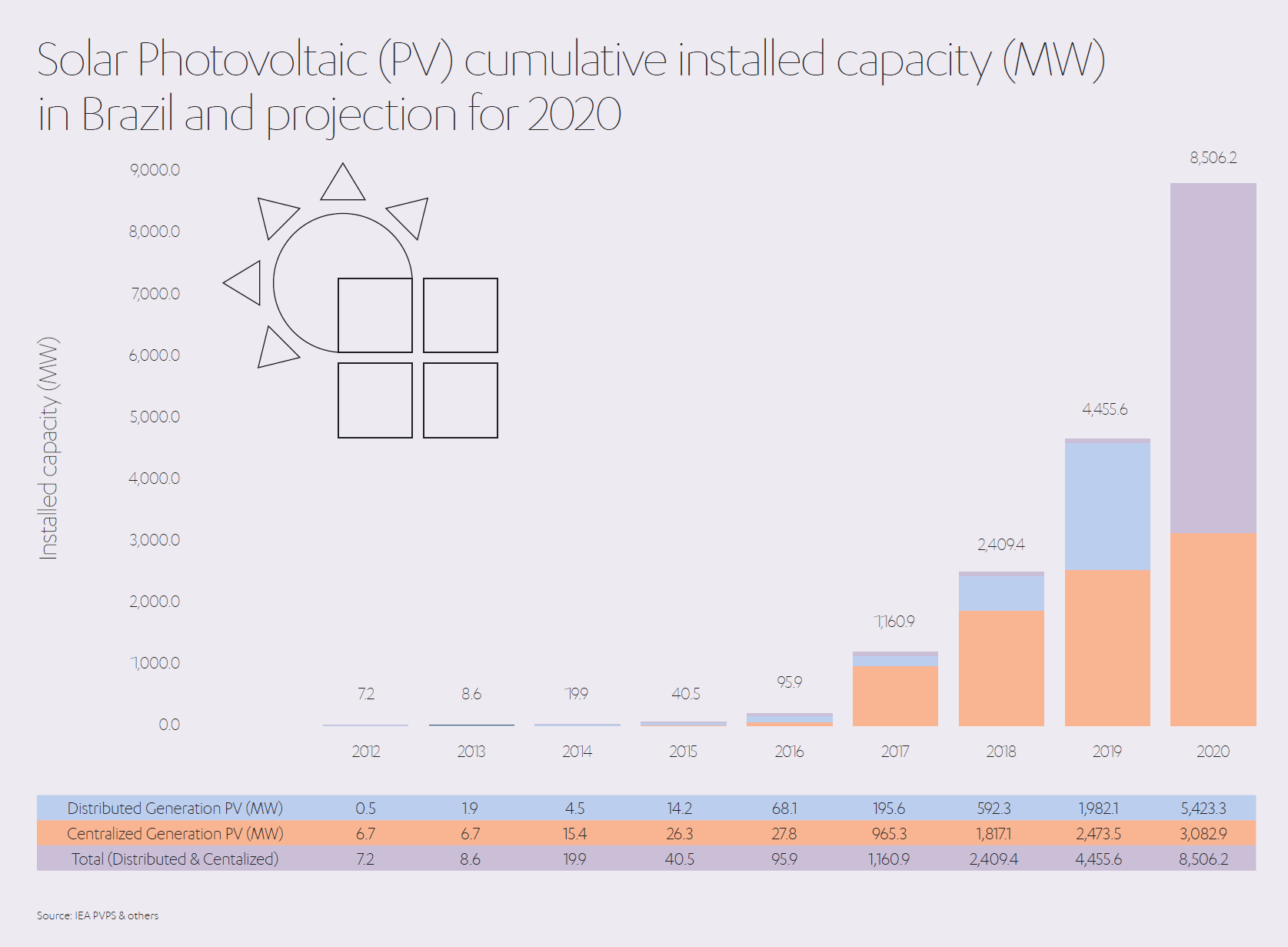
In America, the Solar Energy Industries Association (SEIA) describes the market as “booming”, estimating almost 13 GW of new PV capacity in 2019 split between home, non-residential and utility-scale PV installations[11]. It credits the extension of the USA’s Investment Tax Credit (ITC) with the industry’s steady growth, noting that some 242,000 Americans now work in solar power, generating approximately US$ 17 billion for the country’s economy.
Across the Atlantic, there is similar excitement about solar energy reaching new milestones in Europe. SolarPower Europe’s first EU Market Outlook report shows 16.7 GW of new PV installations in 2019 – a 104% increase over 2018’s 8.2 GW [12]. More new solar capacity was installed than any other power generation technology. [13]
Spain leads the charge, adding 4.7 GW, followed by Germany (4 GW), the Netherlands (2.5 GW) and France (1.1 GW). By the year end, EU states accounted for 131.0 GW of solar power, 14% higher than the previous year’s 115.2 GW. Michael Schmela, Executive Advisor and Head of Market Intelligence at SolarPower Europe, speaking before the pandemic, said: “In terms of medium-term projections, we expect continued growth for the EU-bloc with a 26% increase in 2020 bringing demand to 21 GW, and installations on track to reach 21.9 GW in 2021.”
Certainly, appetite for solar power across Europe showed little sign of waning, pre-virus. In July, Portugal’s huge 1,150 MW auction of solar energy licenses set a new world record, with one of the 24 licenses selling for €14.76 per megawatt hour[14]. And in October, France celebrated the inauguration of the continent’s most powerful floating solar PV plant, the Omega1 project in Piolenc. The 17 MW installation should save the equivalent of 1,096 tons of CO₂ emissions annually.[15]
Despite the challenges, there is evidence to suggest that many solar projects currently in development around the world will avoid falling victim to pandemic panic. In April this year, the Núñez de Balboa solar plant in Spain, described as the largest of its kind in Europe, defied the virus by entering operation on schedule. The 500 MW plant, set to supply clean energy for approximately 250,000 people a year, is operated by Spanish utility company Iberdrola, which still plans a further 2,000 MW of new solar projects across Spain between now and 2022.
Elsewhere in Europe, governments are stretching auction and tender deadlines to help developers adjust to new extended timeframes. Authorities would rather see projects delayed than abandoned, it seems. In France, for instance, solar tenders have been delayed by an average of two months. Likewise, Ireland extended the cut-off for its Renewable Electricity Support Scheme (RESS) from the beginning to the end of April. Portugal, meanwhile, is keeping a watching brief on the virus and has temporarily put on hold its planned solar auctions totaling 700 MW. The licensing auction might now take place in June – if the outbreak starts to slow by then.
Technology helps solar blaze new trails
As 2019 got under way, solar PV’s share of global electricity generation crossed the 2% threshold for the first time.[16] Yet, under the IEA’s Sustainable Development Scenario, by 2040 solar power should be meeting almost one-fifth of the world’s energy requirements.[17]

Such a trajectory means massive growth within the industry, and this in turn requires technological improvements across the board.
In its 2019 Tracking Power report on solar energy, the IEA identified several innovations still needed to unleash solar power’s full potential[18]:
- Better integration of off-grid (such as domestic solar panel) electrification systems.
- A shift towards more cost-efficient energy-capture cells within panels, particularly Passivated Emitter Rear Cells (PERC) and next-generation technologies like Heterojunction (HJT) and Interdigitated Back Contact (IBC) cells.
- Smarter inverters, to cut costs of injecting power into the grid and managing generation from solar PV systems.
Much of this technology remains ‘in the pipeline’ – but wise investments now could help increase energy access globally, particularly in developing countries.
One problem so far hindering the adoption of renewable energy has been consistency of supply. What to do when the wind isn’t blowing or, in this case, the sun isn’t shining?
Crucially, the solar industry is primed for a battery-based revolution in the coming years and decades.
BNEF foresees global energy storage installations swelling from 9 GW (2018) to 1,095 GW by 2040 – a 122-fold increase requiring US$ 622 billion of investment, spurred by a sharp decline in the cost of lithium-ion batteries.[19]
Most of this new capacity will be utility-scale and will enable ‘energy shifting’ – in other words, coordinating the release of energy to the grid from times of excess generation to times of peak use.
While South Korea leads the energy storage market as of 2019, by 2040 China and America are tipped to dominate.
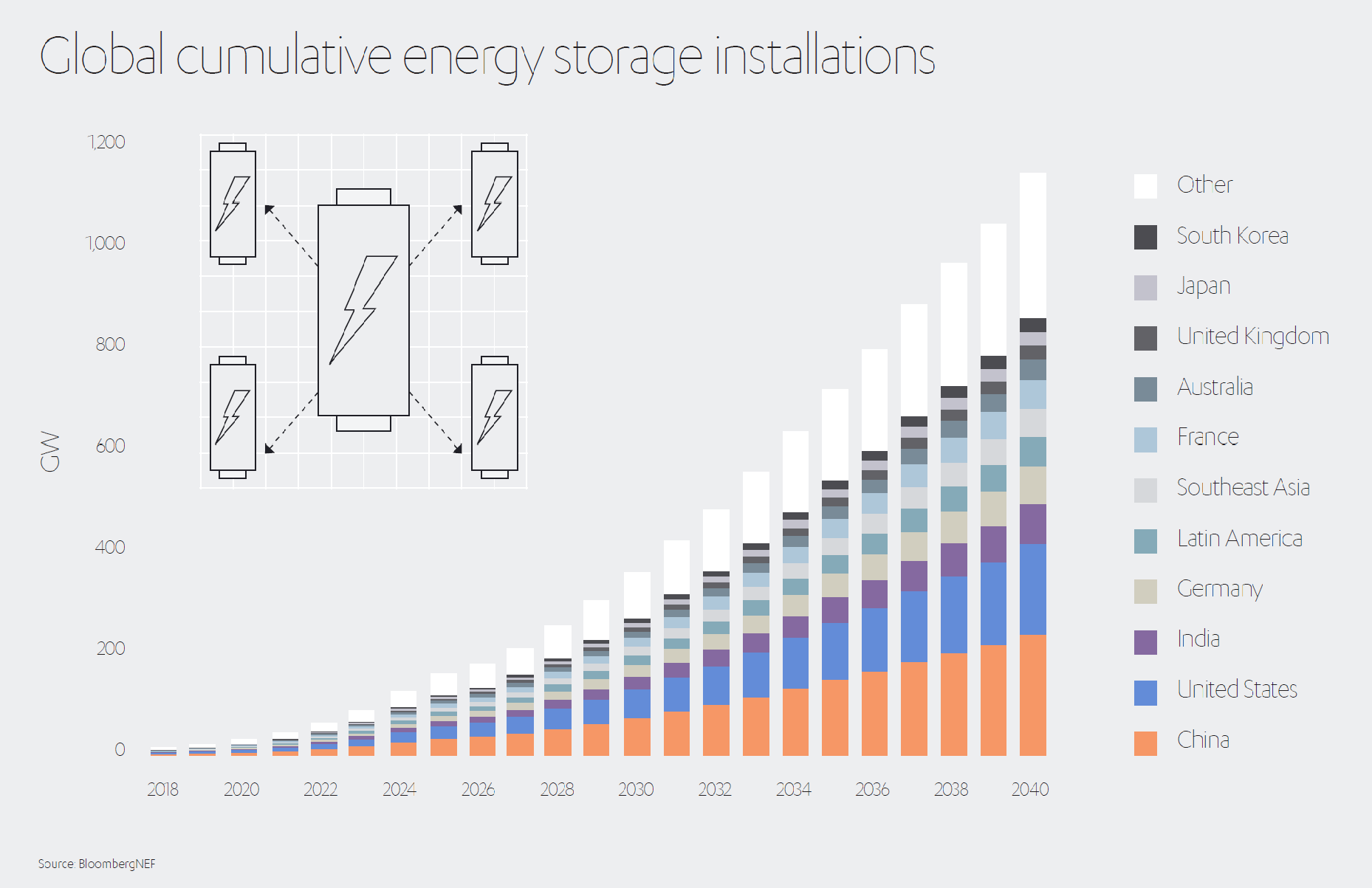
Abdul Latif Jameel Energy is one of the key players driving global battery innovation via renewable energy specialists Fotowatio Renewable Ventures (FRV), which is pioneering the use of utility-scale energy storage systems through its innovation and tech focused division, FRV-X.
Progress is rapid. In 2019 FRV announced its first utility-scale battery project, at Holes Bay UK, in collaboration with British developer Harmony Energy[20].
The scheme comprises a lithium-ion battery array of 15 MWh capacity, connected to the Southern Electric Power distribution network. Commissioning is expected by mid-2020.

“Energy storage plays a central and critical role to fully realize the power of renewable energy,” says Felipe Hernández, Managing Director FRV-X. “FRV acknowledges the value of this technology as a key element to achieve a decarbonized society.”
Peter Kavanagh, CEO of Harmony Energy, said: “It’s a critical time for battery energy storage in the UK and we are pleased to be at the forefront of development. We have over 500 MW of battery energy storage assets construction-ready and with the backing of FRV, we have also pre-qualified 300 MW of new battery energy storage systems into the UK’s capacity market.”
FRV’s pioneering project in Chile, meanwhile, further demonstrates the progress being made in the realms of battery storage. Its revolutionary 540 GW/h hybrid wind-solar plant currently in development will use batteries to provide renewable power round-the-clock for 224,000 homes[21].

“This hybrid combination of solar and wind allows us to provide renewable energy 24/7,” says Manuel Pavon, FRV Managing Director for South America. “During the day we provide solar power, and during the night, wind power. The market is growing.
We expect it will continue increasing up to 1.5 gigawatts per year for the following five years. So, it is a very interesting market for us.”[22]
In a region – Latin America – with a 70% green energy target by 2030, FRV’s 540 GW/h hybrid project represents a true game-changer, and a clue to the future of energy production worldwide[23].
Policy support still pivotal
“Companies and investors are more committed to a cleaner future than ever before, but governments still have the capacity to accelerate – or impede – that process,” noted BNEF in its sustainable energy projections for 2020[24] – and that was before COVID-19 landed to further cloud the waters.
It cited the forthcoming US presidential election in November 2020, as one example of a political variable holding ‘major implications’ for the speed of decarbonization globally. The USA is one of the world’s leading energy generators and consumers, yet current president (and re-election candidate) Donald Trump has so far proved to be more of an advocate of traditional fossil fuels than renewables.
Similarly, the IEA warns that recent corporate tax reforms in the USA have increased uncertainty over the value of new solar projects, causing delays in commissioning as developers seek clarity on the price of PV modules after new tariffs[25].
Developing countries are equally vulnerable to the whims of policy, especially in the renewables sector.
China’s slight 2018 solar slowdown (44 GW of new installations compared to 53 GW in 2017) was, according to the IEA, triggered by the government phasing out feed-in tariffs and introducing deployment quotas to control costs and tackle integration challenges[26]. However, this is acknowledged as a short-term pain, long-term gain scenario, with those new policies expected to make the technology more cost-competitive in future.
Yet, even as evidence mounts of solar power’s susceptibility to policy ebbs and flows, the industry maintains enormous momentum on a global scale. The global crisis unleashed by COVID-19 has thrust the issue of clean energy into the spotlight once more.
Unsurprisingly in these unprecedented times, reactionary voices are calling for energy security to take top priority. Fossil fuels have been the mainstay of our energy generation for as long as anyone alive can remember. As the economic and societal fightback begins against coronavirus, they argue it is these conservative choices that must be prioritized for the benefit of people right here, right now.
In other words, it becomes harder to worry about the future when the present is so harrowing.
And yet, global warming – until now just a symptom of living in an economically-vibrant world – must absorb some of the blame for the situation in which we now find ourselves.
Many scientists believe that by heating the environment at such a dramatic rate, humans have provided viruses with chances to evolve at rates unseen in history.[27] Climate change also shrinks animal populations, hindering the genetic diversity necessary to limit diseases. Depleted natural habitats, meanwhile, force animals into closer proximity with humans, increasing the risk of zoonotic transmission.
Far from taking our foot off the accelerator, now is surely the time to prioritize strategies that can limit climate change and help protect us all. Renewable energies such as solar power are fundamental to this fight.
Right interventions will help industry navigate pandemic
No country, culture or industry will prove immune from the impacts of the pandemic – and solar power is no different. While the situation remains very much in flux, the IEA is already warning that the bountiful 2020 predicted for solar power might be, at least partially, derailed.
The IEA predicts three potential hindrances:
- supply chain and labor disruptions causing delays to projects
- delayed projects in China, the USA and the EU missing 2020 deadlines for government incentives
- possible decrease in investments due to overstretched public and private budgets
“How the situation affects renewables will depend on two key areas: the duration of confinement and social-distancing measures in different countries, and the scope and timing of economic stimulus packages in response to the economic downturn,” says the IEA in its report on the pandemic.[28]
China, the first epicenter of the epidemic, manufactures some 70% of the world’s solar panels. Although supply was interrupted by the lockdown, production is accelerating once more at time of writing as restrictions gradually ease.
To help safeguard the solar industry, the IEA is making three recommendations to governments worldwide:
- extend deadline for commissioning projects beyond 2020 to avoid developers being penalized for missing deadlines
- ensure stimulus packages include financing and incentives for renewables projects
- align response policies with future visions for cutting greenhouse gas emissions
On a hopeful note, the IEA concludes that while small solar projects might prove prone to delays, large projects with grander budgets are likely to have relative immunity. This is because “developers with strong cash positions may be able to handle these construction delays or additional costs they incur in the short and medium term.”
So, while the pandemic’s effects will differ on a project-by-project basis, it seems likely that many of the schemes predicted to have the biggest impact on solar power’s energy share will still proceed, albeit with slightly adjusted timelines.
FRV seizing hot opportunities
In addition to its groundbreaking 540 GW/h hybrid plant in Chile, Abdul Latif Jameel Energy continues to strive to realize solar’s vast potential for both society and the planet by expanding its portfolio of green energy projects around the world.
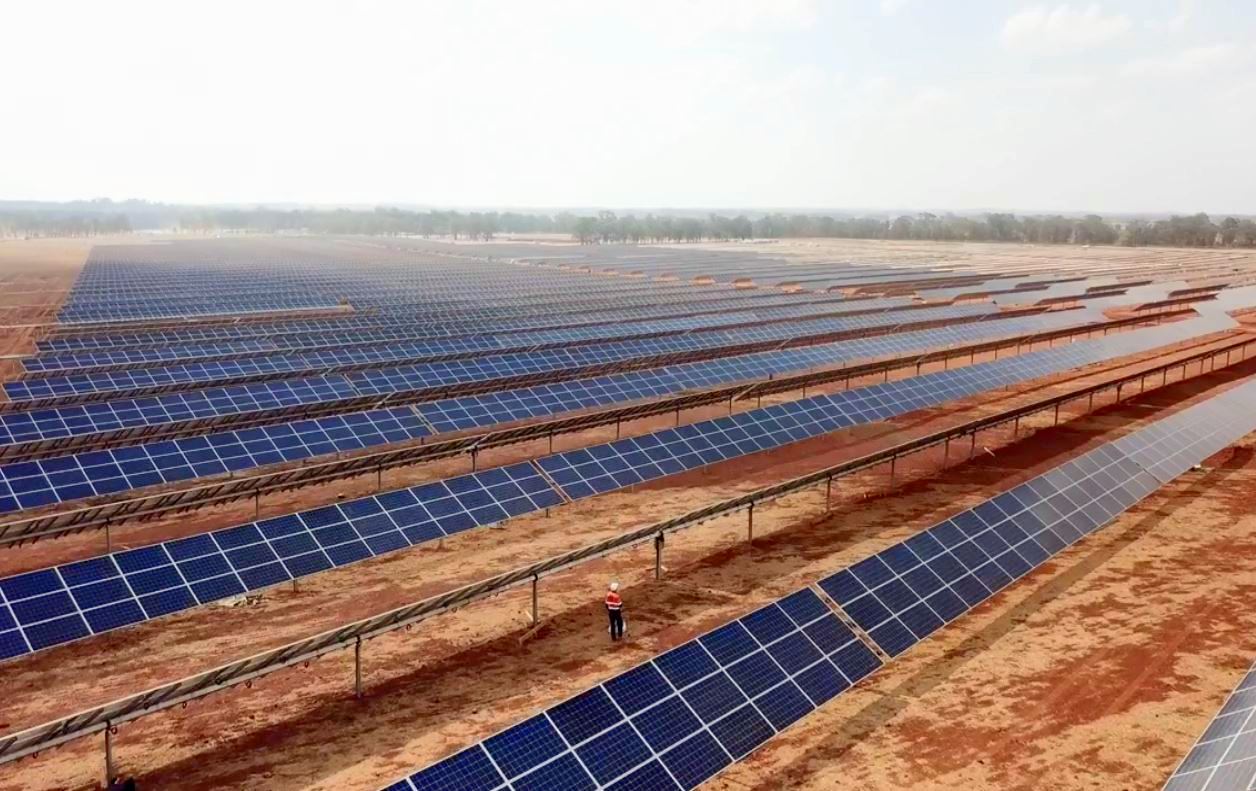
In August 2019, FRV’s 67.8 MW Goonumbla Solar Farm in New South Wales, Australia. The plant connects to the national grid and produces approximately 195,000 MWh of clean energy per year, enough to supply more than 45,000 Australian households and save around 140,000 tons of CO2 annually. Despite coronavirus, the Goonumbla Solar Farm came online and started delivering its first power in May this year.
FRV also secured financing in February 2020 on the 85 MW Winton solar farm in Victoria. This 250-hectare plant, located near Benalla, will generate 210,000 MWh of clean energy annually. The following month, it signed a power purchase agreement (PPA) with its Goonumbla partner Snowy Hydro for a seventh solar venture in Australia. Under the agreement, FRV will deliver power from a 90 MW solar farm at Sebastopol in New South Wales. The plant will connect to the national grid and have a potential annual saving of 77,600 tons of CO2 – equal to 27,700 fewer cars on the road annually.
FRV’s Potosi Solar Plant, in San Luis de Potosi, began operating last year, generating 815,000 MWh annually – enough for over 76,000 homes and to avoid almost 98 million tons of CO2 emissions per year for Mexico.In the northern hemisphere, FRV is spearheading its first two solar projects in Mexico, a country widely identified as one of the best solar resources in the world[29].
FRV’s second Mexican plant, the Potrero PV plant in Jalisco, will generate 750,000 MWh per year when it is completed later in 2020, supplying the equivalent of 128,000 homes and avoiding a further 437,000 tons of CO2 emissions.

“With these two projects we have installed a total of 640 MW of capacity in a Mexican market currently holding around 73,000 MW,” says Fernando Salinas Loring, Managing Director of FRV (Mexico and Central America). “We started operations here four years ago and now represent 0.8% of installed capacity the market, so we have grown to become a relevant player in a very short period of time.”[30]
With coronavirus currently charting a destructive course across Central America, however, the situation in Mexico remains fluid. The Mexican government announced in May that it was pausing grid connections for new solar and wind power projects in the interests of protecting energy security during the pandemic. Doubtless the picture will change as the situation evolves further over the coming months.
As hard data continues to support the near-limitless potential of solar power, FRV will further expand its portfolio to deliver green energy wherever the sun shines brightest.
Solar set for supercharged future
Solar power is destined to continue its global ascendency for as long as the sun continues to shine.
The IEA calculates current world energy consumption of more than 14,000 Mtoe[31] (million tons of oil equivalent) and, if current policies are pursued, expects demand to rise by an average of 1.3% each year to 2040.[32] These figures make a compelling case for harnessing as much free, clean energy as we can – particularly since the Sun’s supply is for all practical purposes limitless.
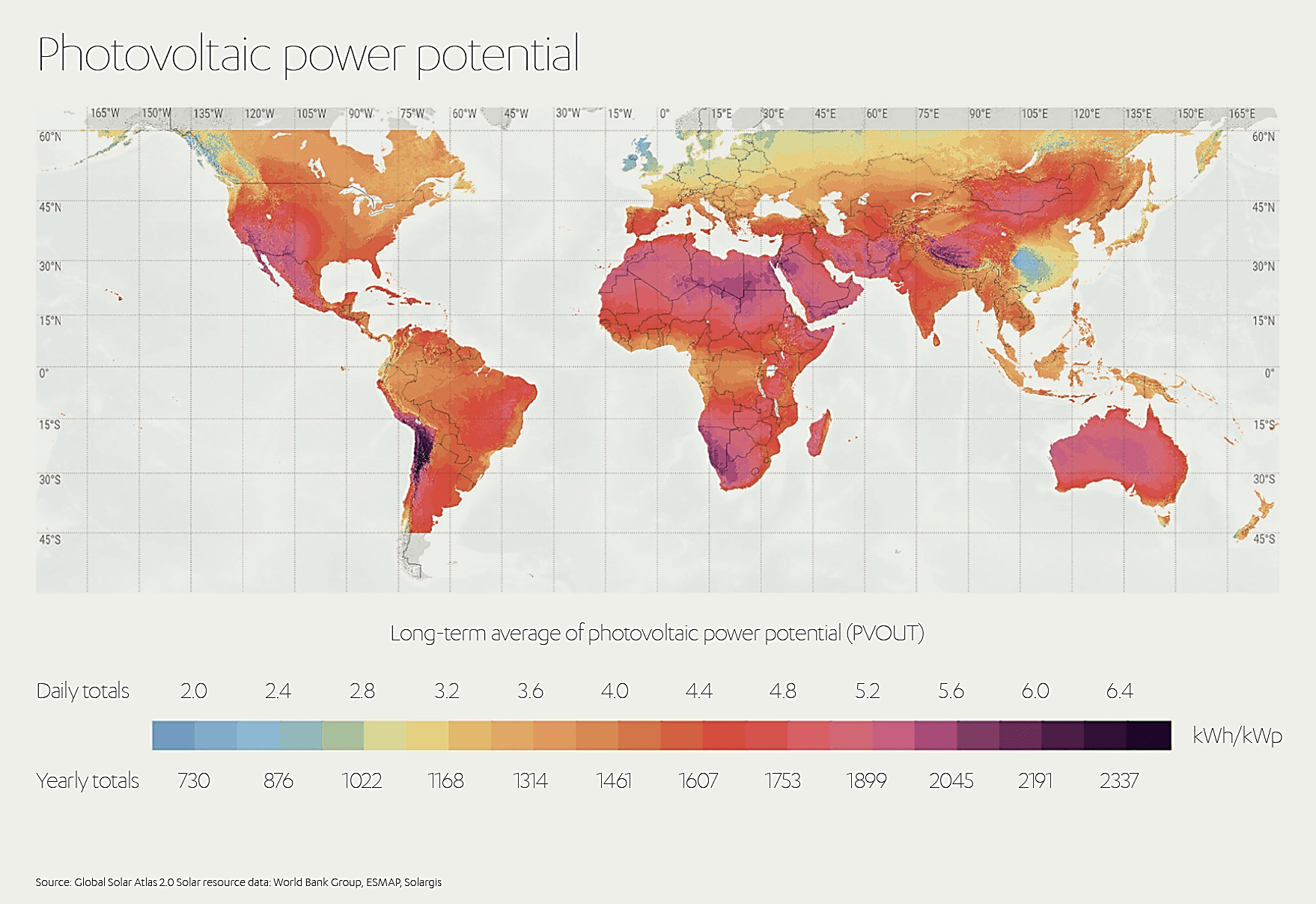
This November’s United Nations Climate Change Conference (COP26), postponed due to the pandemic, would have provided a fresh opportunity for nations to mount a united front against the environmental crisis. The challenges and opportunities presented by climate change, even more potent in the shadow of coronavirus, will be high up the agenda when the conference finally convenes on a date still to be announced in 2021.
Even in the absence of face-to-face interactions, the issue of climate change remains a hot button topic. American documentarian Michael Moore recently stepped into the debate via new project Planet of the Humans, released on YouTube. The film, which Moore executive produced for director Jeff Gibbs, implies that climate mitigation strategies are effectively meritless in a world driven by runaway consumption. If Moore was hoping for a ‘case closed’, he was sadly disappointed. The swiftly-discredited film was accused of recycling debunked fossil fuel industry myths and using out-of-date data.
The IEA is certainly bullish about solar’s prospects. Its Renewables 2019 Market Analysis and Forecast (produced prior to the emergence of coronavirus) predicts renewable electricity capacity increasing 50% from present levels by 2024 – an extra 1,220 GW. Solar will account for a mighty 60% of that expansion, ahead of wind, hydropower and bioenergy.[33]
As current trends demonstrate, the solar industry will continue to serve as a shining beacon for green energy’s promise of securing a cleaner, more sustainable and more prosperous future for all.
[1] https://about.bnef.com/blog/energy-vehicles-sustainability-10-predictions-for-2020/
[2] https://en.wikipedia.org/wiki/Growth_of_photovoltaics
[3] http://www.iea-pvps.org/fileadmin/dam/public/report/statistics/IEA-PVPS_T1_35_Snapshot2019-Report.pdf
[4] https://www.globaldata.com/global-solar-photovoltaic-capacity-expected-to-exceed-1500gw-by-2030-says-globaldata/
[6] https://www.globaldata.com/global-solar-photovoltaic-capacity-expected-to-exceed-1500gw-by-2030-says-globaldata/
[7] https://about.bnef.com/blog/world-clean-energy-investment-slips-1h-2019-despite-billion-dollar-financings-solar-dubai-offshore-wind-taiwan/
[8] http://helioscsp.com/dewa-reviews-construction-of-4th-phase-of-the-mohammed-bin-rashid-al-maktoum-solar-park/
[9] https://www.globalsolarcouncil.org/solar-pv-will-create-over-120-thousand-jobs-in-2020-absolar-projects/
[10] https://www.globaldata.com/covid-19-pandemic-delays-auctions-in-brazil-says-globaldata/
[11] https://www.seia.org/solar-industry-research-data
[12] https://www.solarpowereurope.org/eu-market-outlook-for-solar-power-2019-2023/
[13] https://www.solarpowereurope.org/eu-solar-boom-over-100-solar-market-increase-in-2019/
[14] https://www.euractiv.com/section/energy/news/portugals-solar-energy-auction-breaks-world-record/
[15] https://www.euractiv.com/section/energy/news/europes-largest-floating-solar-plant-opens-in-france/
[16] https://www.iea.org/reports/solar-pv
[17] https://www.powermag.com/iea-world-energy-outlook-solar-capacity-surges-past-coal-and-gas-by-2040/
[18] https://www.iea.org/reports/solar-pv
[19] https://about.bnef.com/blog/energy-storage-investments-boom-battery-costs-halve-next-decade/
[20] https://www.alj.com/en/news/abdul-latif-jameel-energys-frv-to-develop-energy-storage-projects-globally/?id=media_center
[21] https://www.alj.com/en/news/abdul-latif-jameel-energy-power-nearly-quarter-million-homes-chile-solar-wind-energy/
[22] https://www.alj.com/en/perspective/powering-potential-renewable-energy-in-latin-america/
[23] https://www.irena.org/newsroom/articles/2019/Dec/Latin-America-and-the-Caribbean-Announce-Ambitious-New-Renewables-Target
[24] https://about.bnef.com/blog/energy-vehicles-sustainability-10-predictions-for-2020/
[25] https://www.iea.org/reports/solar-pv
[26] https://www.iea.org/reports/solar-pv
[27] https://www.washingtonpost.com/climate-solutions/2020/04/15/climate-change-affects-everything-even-coronavirus/?arc404=true
[28] https://www.iea.org/commentaries/the-coronavirus-pandemic-could-derail-renewable-energy-s-progress-governments-can-help
[29] https://www.alj.com/en/perspective/a-cleaner-stronger-energy-future-dawning-for-mexico/
[30] https://www.alj.com/en/perspective/a-cleaner-stronger-energy-future-dawning-for-mexico/#_ftn1
[31] https://www.iea.org/reports/world-energy-balances-2019
[32] https://www.iea.org/reports/world-energy-outlook-2019
[33] https://www.iea.org/reports/renewables-2019/power#abstract





 1x
1x

 Added to press kit
Added to press kit


